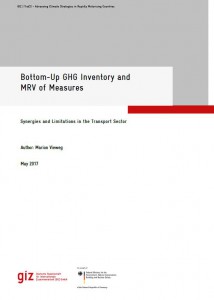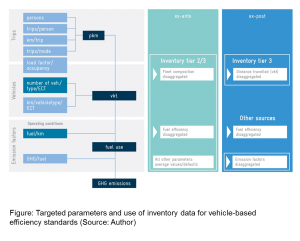New Publication: Bottom-Up GHG Inventory and MRV of Measures in the Transport Sector
 Exploring the synergies and limitations between bottom-up greenhouse gas (GHG) inventories and the Measurement, Reporting & Verification (MRV) of policies and actions in the transport sector – that is the focus of a recently published paper coordinated by GIZ’s Advancing Transport Climate Strategies project and written by Marion Vieweg-Mersmann, founder of Current Future. National GHG emission inventories are vital for reporting transport sector emissions. But to what extent can inventories be used to monitor the success of single mitigation measures? Bottom-up inventory models for transport-related emissions allow for a more detailed analysis in comparison to top-down assessments in national inventories that are based on fuel consumption only. They therefore require an extensive amount of data collection. How far can data collected for inventory preparation be used for the MRV of measures?
Exploring the synergies and limitations between bottom-up greenhouse gas (GHG) inventories and the Measurement, Reporting & Verification (MRV) of policies and actions in the transport sector – that is the focus of a recently published paper coordinated by GIZ’s Advancing Transport Climate Strategies project and written by Marion Vieweg-Mersmann, founder of Current Future. National GHG emission inventories are vital for reporting transport sector emissions. But to what extent can inventories be used to monitor the success of single mitigation measures? Bottom-up inventory models for transport-related emissions allow for a more detailed analysis in comparison to top-down assessments in national inventories that are based on fuel consumption only. They therefore require an extensive amount of data collection. How far can data collected for inventory preparation be used for the MRV of measures?
On the one hand the paper stresses that using data from a bottom-up inventory, such as emission factors, for the MRV of measures enhances the comparability of the effects of measures and can help to develop a consistent national system for data collection and  reporting. On the other hand, data collected for the MRV of measures may be used to increase the level of detail of the inventory. However, differences in geographic boundaries or a lack of detail in inventory data, which is required for MRV of certain measures, can limit the applicability of data from the transport GHG inventory for the MRV of measures. Consequently, it depends on the measure at hand if it can be monitored largely based on data already collected for a bottom-up inventory or if most data needs to be collected separately.
reporting. On the other hand, data collected for the MRV of measures may be used to increase the level of detail of the inventory. However, differences in geographic boundaries or a lack of detail in inventory data, which is required for MRV of certain measures, can limit the applicability of data from the transport GHG inventory for the MRV of measures. Consequently, it depends on the measure at hand if it can be monitored largely based on data already collected for a bottom-up inventory or if most data needs to be collected separately.
Want to learn more? Please download the publication here.
